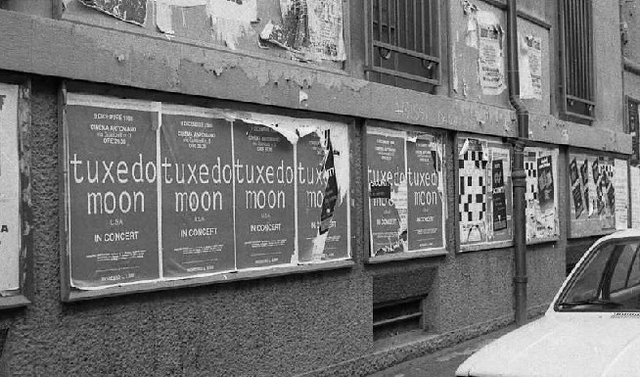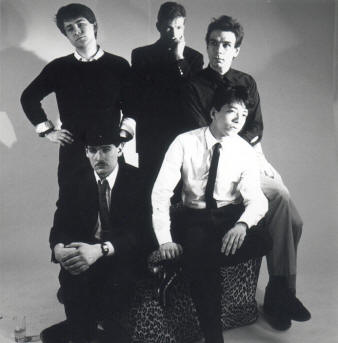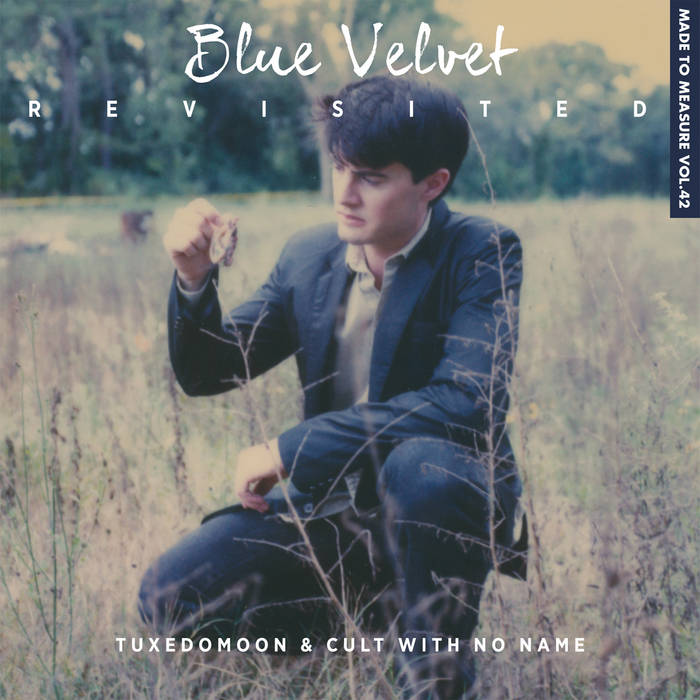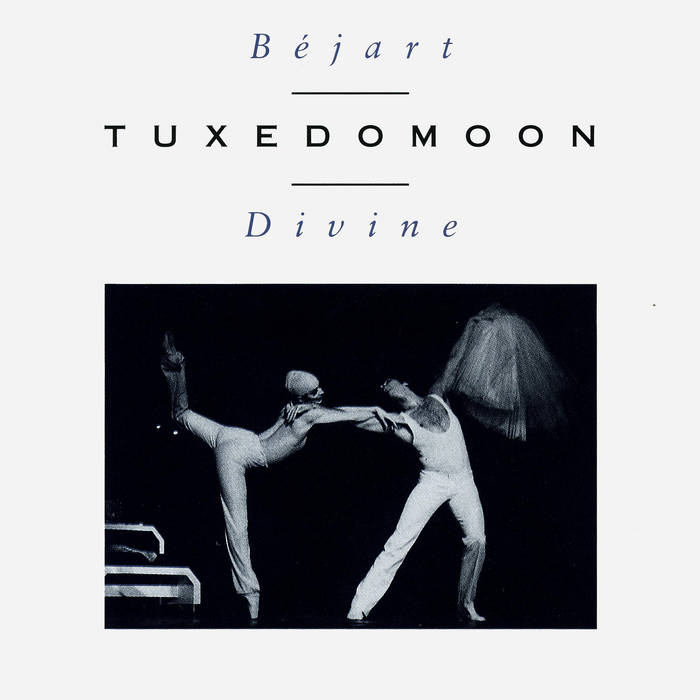
Today, I feature one of my favourite bands TUXEDOMOON. This band is not well known outside of people interested in certain realms of music, labels (Ralph Records), and genres. The great thing about TUXEDOMOON is that they are very difficult to classify. The classifications don't work. It's like much of the RALPH RECORDS catalog. How does one classify the label's signature band: the Residents? You do not. The Residents are in a class by themselves. Fred Frith, Snakefinger, MX-80 Sound, among others are difficult if not impossible to classify.
Look at how the Wikipedia entry struggles to classify TUXEDOMOON: New Wave, experimental, and post-punk. All of which are ways to say that the music does not fit any established, defined, and understood genre.
Here's a short article from the News of Athens, Georgia that may shed some light. See its use of "the no wave scene."
NO WAVE, as in no definable genre.
Tuxedomoon are just making music in an artistic way that intersects with other art forms (dance, visual arts, poetry, television) in complex and nuanced ways.
https://archive.vn/20130218001004/http://www.athensnews.gr/issue/13461/47637
| TUXEDOMOON: A lasting affair | |||||
| |||||
|
Tuxedomoon’s Athens debut in 1988 - when they filled the Pallas theatre twice in the same evening - marked the beginning of a lasting affair between the cult band and their now steady Greek following.
Three years since their last appearance in Greece, the no-wave pioneers behind the major hits “In a Manner of Speaking”, “No Tears” and “Atlantis” are back in Athens for a September 23 one-off gig at Gagarin 205.
The seasoned band started their course over three decades ago in San Francisco’s electronica lab. Their irresistibly ethereal and hypnotic sound incorporated elements from post-punk and jazz to funk and tango.
Before long they landed in New York and became one of the landmark names of the so-called no-wave scene in the city.
To this date their second hit, under the title “No Tears” (1979), is considered in music circles as one of the best electro-punk hymns of all times.
Tuxedomoon’s ability to reinvent themselves soon landed them feature stories in Andy Warhol’s legendary magazine Interview, while the picky Ralph label of avant-garde band Residents released two of their albums, Half Mute and Desire.
The ’80s found Tuxedomoon in Europe. Though they never managed to win over the big markets of Europe and the US, their dark and romantic sound was wholeheartedly embraced by fans of the music underground.
Today the band’s five members are scattered around the world with frontman Blaine Reininger residing in Athens and fellow band members having chosen Mexico, New York and Brussels as their home bases.
Tuxedomoon’s current “global” situation is reflected in their latest releases - Cabin in the Sky, Bardo Hotel and Vapour Trails - which combine a cinematic feel and diverse influences from Miles Davis, Radiohead, Debussy, Michael Nyman and Velvet Underground.
| |||||

Enjoy my Tuxedomoon post. This is a great band. If you are just discovering them, you may be happy and fulfilled now. If you already a fan, I hope you appreciate that I collected a great deal of music and resources via links and text sharing.
Here's some key official links for TUXEDOMOON followed by music.
http://www.tuxedomoon.co/
http://tuxedomoonews.blogspot.com/
https://tuxedomoon.bandcamp.com/
https://tuxedomoonarchives.bandcamp.com/music

Tuxedomoon is an experimental avant-garde post-punk New Wave group formed in San Francisco, California consisting of core members Blaine L. Reininger, Steven Brown and Peter Principle, Luc van Lieshout and video artist Bruce Geduldig.
Formed in 1977 by multi-instrumentalists Blaine L. Reininger and Steven Brown, then two students of electronic music at San Francisco City College, with technical assistance from video artist Tommy Tadlock, Tuxedomoon started playing salons and accompanying performances by The Angels of Light. Brown's connections to local theatre gave the band access to vocalists Gregory Cruikshank, Victoria Lowe, and, most frequently, Winston Tong. The band gained some level of recognition in 1978 when they opened for Devo. Michael Belfer, (guitarist), and Paul Zahl, (drummer) joined the band in time to help with the group's first EP, No Tears. Lowe left prior to the album's release in 1978. Soon afterward, Tong and Belfer left the group temporarily, and bassist Peter Principle joined the lineup. In 1979, the group signed to The Residents' Ralph Records, with whom they recorded their next two albums, Half Mute in 1980 and Desire in 1981, after which the band relocated to Rotterdam for a short time and moved on to Brussels, believing their sound better fit the electronic scene in Europe.
In Brussels, the band soon created the score for a ballet by Maurice Bejart, released in 1982 as "Divine". In 1983 Reininger left the group in order to pursue a solo career, and trumpeter Luc Van Lieshout joined. In 1985 Tuxedomoon had its largest success commercially with the international release of Holy Wars. Tong left the group again soon after its release. Multi-instrumentalist Ivan Georgiev was brought in to perform on the group's next two albums, 1986's Ship of Fools and 1987's You. The band remained inactive through most of the 1990s, although never technically broke up. On July 20, 2004 a reborn Tuxedomoon, consisting of Steven Brown, Blaine Reininger, Peter Principle, and Luc Van Lieshout released a new studio album, Cabin in the Sky. They continue to work and tour together and have since released Bardo Hotel Soundtrack in 2006, with upcoming projects coinciding with the group's 30th year anniversary, the Vapour Trails album and the boxed set 7707.
A more detailed biography of Tuxedomoon has been written by Belgian author Isabelle Corbisier. see "Music for Vagabonds the Tuxedomoon Chronicles".

https://en.wikipedia.org/wiki/Tuxedomoon
Tuxedomoon
Tuxedomoon is an experimental, post-punk, new wave band from San Francisco, California, United States. The band formed in the late 1970s at the beginning of the punk rock movement. Pulling influence from punk and electronic music, the group, originally consisting of Steven Brown (born Steven Allan Brown on August 23, 1952, in Chicago, Illinois) and Blaine L. Reininger, used electronic violins, guitars, screaming vocals and synthesizers to develop a unique "cabaret no-wave" sound. Bassist Peter Principle (Peter Dachert, 1954–2017) joined the band and in 1979 they released the single "No Tears," which remains a post-punk cult classic. That year they signed to Ralph Records and released their first album, Half-Mute. Eventually, Reininger left the group and Tuxedomoon relocated to Europe, signing to Crammed Discs and releasing Holy Wars in 1985. The band separated in the early 1990s, only to reunite later that decade. They all have remained together since releasing the album Cabin in the Sky in 2004.
History[edit]
In 1977, Tuxedomoon formed out of The Angels of Light, an artist collective and commune, a group in which Steven Brown was involved.[1][2][3] He met Blaine L. Reininger in an electronic music class at San Francisco City College. Brown worked with Tommy Tadlock, of the Angels of Light, to create the final project of the class.[2] Tadlock would go on to be Tuxedomoon's manager. Reininger and Brown started playing music together at Tadlock's house. Reininger played electronic violin and guitar. Tadlock assisted with the sound and audio. He also created tools for the band, including a "Treatment Mountain", which was a pyramid made of plywood which held all of Reininger's effects pedals.[4]
They started playing music together in the mid-1970s, when punk rock became popular in the underground music scene. "The only rule was the tacit understanding that anything that sounded like anyone else was taboo", stated Brown on the band aiming the create music that sounded unlike anything else before.[2] The vocals were screaming and inspired by punk rock, and the band used any instruments they had around, including saxophones and a polymoog synthesizer. The band had no drummer. Bassist Peter Principle, performance artist Winston Tong and Bruce Geduldig, a filmmaker, joined the band during concerts. The band created new performances for each concert, creating theatrical performances and being described as "theatrical electronic cabaret".[4][5] The band performed frequently with Pere Ubu, The Residents, Devo, and Cabaret Voltaire.[1]
In 1979 they released the EP No Tears with the single "No Tears". The title-track is described as "one of the best electro-punk hymns of all times".[6] That year they also signed to Ralph Records and released their debut album, Half-Mute, in 1980.[1]
Career[edit]
1980s[edit]
In 1980 the band released their first album, Half-Mute, on Ralph Records. The band toured Europe in 1980 and moved to New York City.[1][3][7] While in New York, they performed in, and were featured on the soundtrack for the film Downtown 81.[3] They gained popularity in the Netherlands and Belgium.[8] They eventually relocated to Brussels.[3]after spending some months in Rotterdam, playing in Arena, Hal 4 and returned in 1988 to Lantaren/Venster, where they contributed to the Bob Visser movie Plan Delta. Trumpet player Luc van Lieshout joined the band, followed shortly after by Ivan Georgiev.[3] In 1987, the band performed on the soundtrack for the Wim Wenders film Wings of Desire.[9] Tuxedomoon played in Athens, Greece, for the first time on December 1987, selling out the Pallas Theatre twice in one night.[6]
1990s[edit]
In the early 1990s, the band separated and did not reunite for approximately eight years.[1] Tuxedomoon reunited to perform at the Next Festival in Tel Aviv. The band hadn't played together in eight years, when Brown called the members to come together for the concert. They rehearsed in a studio for 10 days, in Tel Aviv, before the concert. Brown credits the Next Festival concert as being the key event in reuniting the band.[1]
2000s[edit]
Tuxedomoon performed in 2000, playing acoustic and electronic concerts of previously recorded material.[10]
Their 2004 album Cabin in the Sky would serve as their comeback record.[11] The majority of the record is instrumental. Reininger's voice, which was compared to David Bowie's during Tuxedomoon's early career, has been described as evolving into "Tom Waits" and a wolf from Tex Avery's "Baron Brown", by music critic Rod Smith. Filmmaker Bruce Geduldig performs backup vocals on the album.[3]
In 2006 the band released Bardo Hotel on Crammed Discs. Recorded in San Francisco, the album is a soundtrack to a film by George Kakanakis, which at the time of the album's release, remained unfinished. The album and film are named after the book Beat Museum – Bardo Hotel by Brion Gysin, which is named after the Bardo Hotel in Paris.[11][12] The soundtrack and film pulled influence from Gysin's "cut-up" method, which was co-developed with William S. Burroughs. The recording features samples of airplane sounds, BART announcements and other found sounds. New Orleans jazz and opera are two influences for the album's sound.[12]
Tuxedomoon released the album Vapour Trails on Crammed Discs in 2007.[11] The album was recorded at Reininger's home.[13] The band uses instruments like clarinets and flugelhorns along with their standard instrument setup.[13] In 2007, they also released a CD and DVD boxset of unreleased and rare music and videos.[11] Various Tuxedomoon members have extensively collaborated with the UK band Cult With No Name, and as a group Tuxedomoon collaborated to produce the joint soundtrack album "Blue Velvet Revisited," (the documentary of which will appear as a feature on the Criterion Collection's DVD and Blu-ray Special Edition of Blue Velvet.)[14] Members have also joined the FuturePlaces medialab for citizenship in 2010, 2011 and 2013, their participation documented in Bandcamp audio releases.
The Box, a 10-vinyl boxed set containing 9 of Tuxedomoon's major albums, as well as an album of previously unreleased material, came out in November 2015.
Current[edit]
Geduldig (born Bruce Frederick Geduldig on March 7, 1953 in California) died on March 7, 2016, in Sacramento, California, he was 63 years old.[15] David Haneke has taken over Geduldig's duties in Tuxedomoon for their 2016 tour.[16] [17]
Legacy[edit]
Scooter's "My Eyes Are Dry" from their album Mind The Gap is a cover version of "No Tears" with additional sections.
Musical style[edit]
Steven Brown cites the band's early influences as "Eno, Bowie, John Cage, Bernard Herrmann, Nino Rota, Igor Stravinsky and Ennio Morricone".[11] Later and current influences include Radiohead, Claude Debussy, Miles Davis, Michael Nyman and the Velvet Underground. Their music finds influence in genres such as punk rock, jazz, funk, tango, and post-punk.[6]
Music critic Simon Reynolds wrote that their sound has an "aura of jaded elegance", with a more European style musically versus what their American counterparts were creating at the time of the band's formation.[20] Seattle Weekly described their music as radiating "a discomfort that hints of existential hives."[3]
Lyrically, Tuxedomoon examined society, culture and psychology. "Holiday for Plywood", on Desire, examined consumerism and paranoia.[20]
Discography[edit]
- Half-Mute (1980)
- Desire (1981)
- Divine (1982)
- Holy Wars (1985)
- Ship of Fools (1986)
- You (1987)
- The Ghost Sonata (1991)
- Joeboy in Mexico (1997)
- Cabin in the Sky (2004)
- Vapour Trails (2007)
- Pink Narcissus (2014)
- Blue Velvet Revisited w/ Cult With No Name (2015)
http://tuxedomoonews.blogspot.com/2017/07/a-eulogy-for-peter-from-neil-martinson.html
Monday, July 17, 2017
A Eulogy for Peter from Neil Martinson
I was deeply saddened to hear that a dear friend of mine named Peter Principle (née Dachert) passed away today. Peter was a truly remarkable person, a brilliant musician, and an inspiring intelligence.
Ever since my teens, I had seen him play bass in the amazing band Tuxedomoon, and admired his unique style. I was also quite enamored of his solo albums "Sedimental Journey" and "Tone Poems" – both beautiful examples of 1980s style magnetic-tape music. Over the years I met a few of the other guys in the band (Steven, Blaine, Michael, Winston Tong, the recently departed Bruce Geduldig), and when I asked my good pal, the graphic designer Patrick Roques about him, he described Peter as "a walking Amok Press catalog"…
In 1990, I arranged to meet Peter for an interview which ended up being published in the first issue of my magazine Proof. We hit it off right away, and as it turned out, this first meeting would dramatically change the course of my life forever. Aside from being generally impressed with this tall, dignified, stentorian and highly articulate entity, during the course of this first conversation I was introduced to numerous things that would deeply influence my thinking, including Anthroposophy and a particularly profound Alchemical/Rosicrucian worldview. Those who know me well understand how significant all this is for me. Well, it was largely Peter's influence that set me on that path!
Over the years, we became pretty close and spent a lot of time together. He did the final mix of some recordings by my band Mercurians (some of which were released on a 45), and I was instrumental in arranging Tuxedomoon's last US appearance over a decade ago. In addition to being a warm and generous friend, he continued to introduce me to tons of amazing music, film, and esoteric knowledge; to say he was an influence seems a dramatic understatement. Getting to know Peter was absolutely revolutionary for my mind, and I was always proud and excited to introduce him to various friends of mine. Pretty much anyone who met him was equally astounded and transformed by him.
It must be noted that he had quite a temper and would occasionally explode about something seemingly small, like a book borrowed and not returned in a timely manner. Once during a heated phone call I told him to "stop yelling at me" and he immediately softened, gently explaining "well, if I don't yell it seems like nobody ever listens." He occasionally complained of people treating him poorly, condescending to him, insulting him and downright ripping him off. He was not shy about naming names, and many of his alleged detractors were people well-established in the avant garde music world. I sometimes wonder if he didn't imagine some of these slights, though I really have no way of knowing. Mostly, I found it hard to imagine anyone not liking him! It definitely conveyed a certain sense of loneliness and shyness, which I don't think most people who met him were aware of, as well as a generally well concealed class-conscious insecurity. He described his upbringing to me as quite rough and tumble and would joke about being "just a yobbo from Queens," although I gather his household prided itself as "enlightened proletariat." I suspect his bold demeanor and choleric temperament may have been offputting to some. In many ways he was a classic Sagittarian and definitely rode a pretty high horse! In any case, I felt honored that he was comfortable enough around me to reveal this vulnerable side of his complex personality.
The last time I saw him, he stormed up to me and griped about being "almost dead!" It was indeed quite offputting, but I do believe he was having a hard time financially and emotionally during his last few years in New York City. He had a wonderful girlfriend at the time and I gather they moved off to Kentucky or Tennessee or somewhere flabbergasting like that for several years … His landline was disconnected and we lost touch, and I regret not making more effort to reach out to him during these last few years. I had been hoping to arrange for Tuxedomoon to come back and play the United States again, and I just figured we'd be reunited some sunny day and pick up where we left off with some more wonderful conversations. Now it looks like I'll have to wait until some future incarnation!
Blessings on all your future endeavors, friend of ages.
Neil Martinson




SOME MORE LINKS FOR GOOD READING
https://thequietus.com/articles/19397-tuxedomoon-the-vinyl-box-review
http://www.trouserpress.com/entry.php?a=tuxedomoon
https://lesdisquesducrepuscule.com/tuxedomoon_at_twilight_twi054cd.html
https://thevinylfactory.com/news/tuxedomoon-new-10lp-box-set-complete-story-crammed-discs/

https://www.radiopanik.org/actus/our-man-from-brussels-plays-tunes-for-tuxedomoon-half-mute-first-concert
http://www.peek-a-boo-magazine.be/en/interviews/blaine-l-reininger-tuxedomoon/
It fitted in the ambition of Tuxedomoon to combine music, theatre, film…
Yes, sure. Just before that, this English man we were working with told us to ask the English Art Council for a grant. He saw that we were kind of arty guys. And so we did. I wrote a proposal to the Art Council in Nottingham. Surprisingly enough, they came through with a residency for us. We had a three week residency in Nottingham in England. The idea was to organize some performance using local people, in different ways. Winston was involved, I was involved, we had some high school girls who were playing the string arrangements I wrote, we had a local band called The Howdy Boys. They were never heard of again. They played a couple of songs. We gave lectures and did performances in schools. It was while doing this ‘community theatre’ that some of the ideas for Ghost Sonata were born. That piece was kind of a prototype for what would come later. We then had this commission from this theatre festival ‘Polverigi’ in Italy to do a big performance. That was The Ghost Sonata.
Most of that took place in a video studio in Ixelles, called Pyramide Video Studio. The idea was to have live action synchronized with the video. They made the costumes and the stage props. It was foremost Winston’s doing. They worked on that every day. I decided I didn’t want to be involved in that. I worked on the music, the orchestrations in particular. Steven and I had written the music. We had a one of gig in a café in the center of Brussels, at the Grand Place: Le Paradis Tropical. There was a piano and a rehearsal studio. Steven and I went in and started to improvise with piano and violin. That’s how we always work. He played, I played, and it went on and on and on. I took some of that material, and I wrote it for orchestra. When I went to Italy, I had a sort of community, a volunteer orchestra of musicians from the town. I wasn’t involved in the stage show. I conducted the orchestra.
https://www.jazzwise.com/other/article/tuxedomoon-purcell-room-monday-19-nov-london-jazz-festival
http://www.pennyblackmusic.co.uk/MagSitePages/Article/8279/Favourite-Album-Reviews/Tuxedomoon-Half-Mute
Origin Stories: Tuxedomoon
+++++++++++++++++++++++++++++++++++++++++++++++++++++++++++++++++++++++
+++++++++++++++++++++++++++++++++++++++++++++++++++++++++++++++++++++++
+++++++++++++++++++++++++++++++++++++++++++++++++++++++++++++++++++++++
- Bloggery committed by chris tower - 2005.11 - 10:10
- Days ago = 1773 days ago
- New note - On 1807.06, I ceased daily transmission of my Hey Mom feature after three years of daily conversations. I plan to continue Hey Mom posts at least twice per week but will continue to post the days since ("Days Ago") count on my blog each day. The blog entry numbering in the title has changed to reflect total Sense of Doubt posts since I began the blog on 0705.04, which include Hey Mom posts, Daily Bowie posts, and Sense of Doubt posts. Hey Mom posts will still be numbered sequentially. New Hey Mom posts will use the same format as all the other Hey Mom posts; all other posts will feature this format seen here.





No comments:
Post a Comment